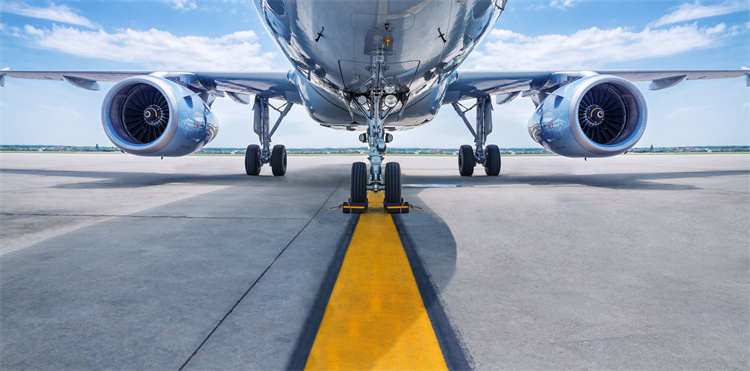Intensified Competition in Air Logistics: An In-depth Analysis

The air logistics industry plays a crucial role in global trade and commerce. Recent years have seen intensified competition within this sector, driven by technological advancements and evolving customer expectations. Understanding the competitive dynamics becomes essential for stakeholders aiming to thrive in this fast-paced environment. The market value of the air cargo industry reached $197 billion in 2022, despite a 10.8% decrease from the previous year. Projections indicate significant growth, with the market expected to reach $201.57 billion by 2029, growing at a CAGR of 5.92%.
Overview of the Air Logistics Industry

Historical Context
Evolution of Air Logistics
The air logistics industry has undergone significant transformations since its inception. The Second World War marked a pivotal moment, accelerating the development of air cargo transportation. The war demonstrated the strategic importance of air travel, laying the groundwork for the growth of commercial air freight services.
The end of the 1960s saw a breakthrough with the introduction of the first wide-bodied aircraft. This innovation revolutionized air freight by increasing cargo capacity and reducing transportation costs. The 1990s witnessed another leap forward with the introduction of cargo planes exclusively for freight transportation. The rise of express package services and the expanding power of the internet fueled this development.
Technological advancements and the demand for e-commerce have further reshaped the air cargo logistics industry. These factors have driven efficient supply chain management and seamless distribution of goods.
Key Milestones
Several key milestones have defined the evolution of air logistics:
1940s: Acceleration of air cargo transportation due to World War II.
1960s: Introduction of the first wide-bodied aircraft.
1990s: Emergence of cargo planes exclusively for freight.
2000s: Growth driven by technological advancements and e-commerce demand.
Current Market Landscape
Major Players
The air logistics industry features several major players that dominate the market. Companies like FedEx, UPS, and DHL lead the sector with extensive global networks and advanced logistics solutions. These companies have invested heavily in technology and infrastructure to maintain a competitive edge.
Airlines such as Emirates SkyCargo, Lufthansa Cargo, and Cathay Pacific Cargo also play crucial roles. These airlines offer specialized cargo services and leverage their passenger flight networks to optimize freight operations.
Market Segmentation
The air logistics market can be segmented based on various criteria:
Service Type: Express services, standard air freight, and charter services.
End-User: E-commerce, pharmaceuticals, automotive, and perishables.
Geography: North America, Europe, Asia-Pacific, and other regions.
Each segment presents unique opportunities and challenges. For instance, the e-commerce segment demands faster delivery times and flexible logistics solutions. The pharmaceutical segment requires stringent temperature control and regulatory compliance.
Understanding these segments helps stakeholders tailor their strategies to meet specific market needs.
Factors Driving Intensified Competition
Technological Advancements
Automation and AI
Automation and AI have revolutionized air logistics. Automated systems streamline cargo handling, reducing human error and increasing efficiency. AI algorithms optimize routing and scheduling, ensuring timely deliveries. These technologies enhance operational efficiency and reduce costs, giving companies a competitive edge.
Scientific Research Findings:
Impact of Technological Advancements and Globalization on Competition in Air Logistics: The study found that adopting emerging technological innovations leads to efficient operations and quality service delivery.
Adoption of Technological Innovations in the Air Cargo Logistics Industry in South Africa: The study established that technologically driven operations and warehousing significantly determine quality service delivery.
Digital Platforms
Digital platforms have transformed the air logistics industry. Online booking systems allow customers to schedule shipments easily. Real-time tracking provides transparency, allowing clients to monitor their cargo. These platforms improve customer satisfaction and streamline operations.
Scientific Research Findings:
Effects of Technological Innovations on Air Cargo Operations: The study found that applying technological innovations enhances cargo service qualities for customer satisfaction.
Globalization and Trade Policies
Impact of Trade Agreements
Trade agreements have a profound impact on air logistics. Agreements like NAFTA and the EU Single Market facilitate cross-border trade. These agreements reduce tariffs and simplify customs procedures, making international shipping more attractive. Companies benefit from expanded markets and increased demand for air freight services.
Regional Market Dynamics
Regional market dynamics shape competition in air logistics. North America and Europe dominate the market due to advanced infrastructure and high demand. Asia-Pacific shows rapid growth, driven by manufacturing and e-commerce. Companies must adapt to regional differences to remain competitive.
Customer Expectations
Demand for Faster Delivery
Customers now demand faster delivery times. E-commerce growth has heightened expectations for quick shipping. Companies must invest in efficient logistics solutions to meet these demands. Faster delivery times increase customer satisfaction and loyalty.
Customization and Flexibility
Customization and flexibility have become crucial in air logistics. Clients seek tailored solutions to meet specific needs. Companies offer personalized services, such as temperature-controlled shipping for pharmaceuticals. Flexibility in operations ensures that companies can adapt to changing customer requirements.
Impact of Intensified Competition on Stakeholders
Airlines and Logistics Companies
Competitive Strategies
Airlines and logistics companies must adopt innovative strategies to stay ahead. Investment in technology becomes crucial. Companies like FedEx and UPS leverage automation and AI to optimize operations. Digital platforms enhance customer interaction and streamline booking processes. Strategic partnerships with tech firms help integrate advanced solutions. Diversification of services, such as offering express and standard freight options, attracts a broader customer base.
Operational Challenges
Intensified competition brings several operational challenges. Companies face pressure to reduce costs while maintaining high service quality. The need for faster delivery times strains existing infrastructure. Airlines must manage fluctuating fuel prices and regulatory compliance. Logistics companies encounter difficulties in maintaining efficient supply chains. The rapid rise of e-commerce demands scalable solutions to handle increased volumes.
Customers and Clients
Benefits and Drawbacks
Customers benefit from intensified competition through improved services. Faster delivery times and real-time tracking enhance customer satisfaction. Competitive pricing offers cost savings for businesses and individuals. However, there are drawbacks. Increased competition can lead to overcapacity, causing delays and inefficiencies. Customers may experience inconsistent service quality due to cost-cutting measures.
Changing Preferences
Customer preferences evolve in response to market dynamics. The demand for personalized services grows. Clients seek tailored solutions for specific needs, such as temperature-controlled shipping for pharmaceuticals. Flexibility becomes a key factor, with customers expecting adaptable logistics solutions. The emphasis on sustainability rises, with clients preferring companies that reduce their carbon footprint.
Regulatory Bodies
Compliance and Standards
Regulatory bodies play a vital role in maintaining industry standards. Compliance with international regulations ensures safe and efficient operations. Authorities enforce standards related to cargo handling, security, and environmental impact. Airlines and logistics companies must adhere to these regulations to avoid penalties and maintain their reputation.
Policy Changes
Policy changes significantly impact the air logistics industry. Deregulation and liberalization have increased competition by allowing more players into the market. Trade agreements like NAFTA and the EU Single Market facilitate cross-border trade. These policies reduce tariffs and simplify customs procedures, benefiting companies and customers. However, regulatory changes can also introduce new compliance requirements, adding complexity to operations.
Strategic Responses to Intensified Competition

Innovation and Technology Adoption
Investment in R&D
Investment in research and development (R&D) drives innovation in air logistics. Companies allocate significant resources to develop new technologies and improve existing systems. This investment leads to advancements in automation, artificial intelligence, and data analytics. These technologies enhance operational efficiency and reduce costs. For example, automated cargo handling systems minimize human error and expedite processing times. AI algorithms optimize routing and scheduling, ensuring timely deliveries.
Industry Experts emphasize the importance of R&D in maintaining a competitive edge. According to experts, integrating advanced technologies into supply chains can sustain growth even as the e-commerce market matures. Companies that prioritize R&D will continue to reap the rewards of a dynamic market.
Collaboration with Tech Firms
Collaboration with technology firms accelerates innovation. Air logistics companies partner with tech firms to integrate cutting-edge solutions into their operations. These partnerships bring expertise and resources that drive technological advancements. For instance, collaborations lead to the development of digital platforms for real-time tracking and online booking. These platforms enhance customer satisfaction by providing transparency and convenience.
Experts highlight the need for the industry to embrace technology. According to Industry Experts, the ability to automate processes and streamline compliance requirements will determine the industry's success. Partnerships with tech firms facilitate this transformation, enabling companies to stay ahead in a competitive market.
Market Diversification
Exploring New Routes
Exploring new routes offers opportunities for growth. Air logistics companies expand their networks to reach untapped markets. New routes provide access to regions with high demand for air freight services. This expansion diversifies revenue streams and reduces dependence on established markets. For example, companies explore routes in emerging economies with growing manufacturing sectors. These regions present lucrative opportunities for air logistics services.
Industry Experts note that regional market dynamics shape competition. Companies must adapt to regional differences to remain competitive. Exploring new routes allows companies to capitalize on these dynamics and gain a foothold in emerging markets.
Expanding Service Offerings
Expanding service offerings attracts a broader customer base. Air logistics companies diversify their services to meet varying customer needs. For instance, companies offer express services for time-sensitive shipments and standard freight options for less urgent deliveries. Specialized services, such as temperature-controlled shipping for pharmaceuticals, cater to specific industries. This diversification enhances customer satisfaction and loyalty.
Experts stress the importance of tailored solutions. According to Industry Experts, customers seek personalized services that address their unique requirements. Expanding service offerings enables companies to meet these demands and maintain a competitive edge.
Enhancing Customer Experience
Personalized Services
Personalized services enhance customer experience. Air logistics companies offer tailored solutions to meet individual client needs. For example, temperature-controlled shipping ensures the safe transport of sensitive goods like pharmaceuticals. Customized packaging options protect fragile items during transit. These personalized services build customer trust and satisfaction.
Industry Experts emphasize the growing demand for customization. Clients expect flexible logistics solutions that adapt to their specific needs. Companies that provide personalized services will attract and retain loyal customers.
Improved Communication Channels
Improved communication channels strengthen customer relationships. Air logistics companies invest in digital platforms that facilitate seamless communication. Real-time tracking systems allow clients to monitor their shipments from order to delivery. Online booking systems simplify the scheduling process. These platforms provide transparency and convenience, enhancing the overall customer experience.
Experts highlight the importance of efficient communication. According to Industry Experts, the ability to provide simple and easy traceability is crucial for customer satisfaction. Companies that invest in improved communication channels will gain a competitive advantage in the market.
The analysis of intensified competition in air logistics highlights several key points. The industry has evolved significantly due to technological advancements, globalization, and changing customer expectations. Strategic planning remains crucial for stakeholders to navigate these dynamics effectively.
Stakeholders must prioritize innovation and technology adoption. Investment in research and development drives operational efficiency and cost reduction. Collaboration with tech firms accelerates the integration of advanced solutions.
The future of air logistics will depend on the ability to adapt quickly to market changes. Strategic partnerships, cutting-edge technologies, and robust infrastructures will dominate the industry. Embracing these elements ensures success in a competitive landscape.
See Also
Decoding the Analysis: The Future of LTL Freight
Unlocking Efficiency: Insider Tips for Logistics Savings
Tomorrow's Logistics Revolution: AI in the Supply Chain
